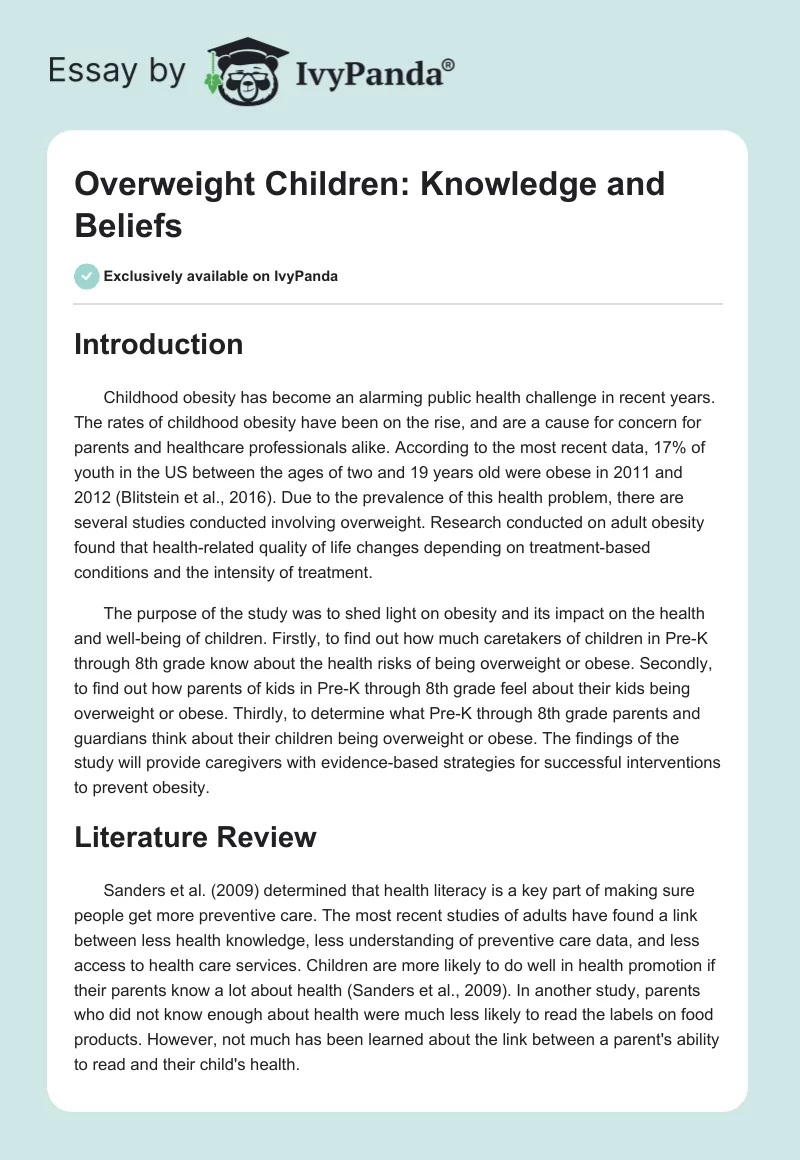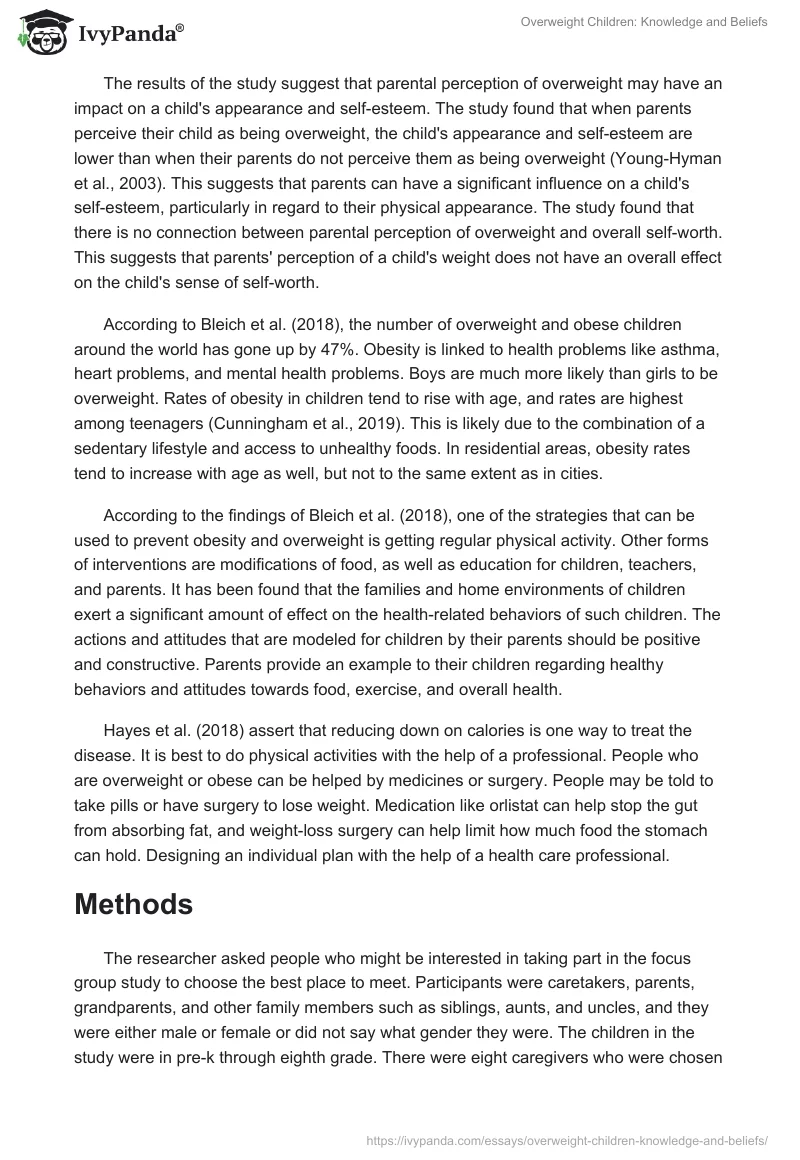Introduction
Childhood obesity has become an alarming public health challenge in recent years. The rates of childhood obesity have been on the rise, and are a cause for concern for parents and healthcare professionals alike. According to the most recent data, 17% of youth in the US between the ages of two and 19 years old were obese in 2011 and 2012 (Blitstein et al., 2016). Due to the prevalence of this health problem, there are several studies conducted involving overweight. Research conducted on adult obesity found that health-related quality of life changes depending on treatment-based conditions and the intensity of treatment.
The purpose of the study was to shed light on obesity and its impact on the health and well-being of children. Firstly, to find out how much caretakers of children in Pre-K through 8th grade know about the health risks of being overweight or obese. Secondly, to find out how parents of kids in Pre-K through 8th grade feel about their kids being overweight or obese. Thirdly, to determine what Pre-K through 8th grade parents and guardians think about their children being overweight or obese. The findings of the study will provide caregivers with evidence-based strategies for successful interventions to prevent obesity.
Literature Review
Sanders et al. (2009) determined that health literacy is a key part of making sure people get more preventive care. The most recent studies of adults have found a link between less health knowledge, less understanding of preventive care data, and less access to health care services. Children are more likely to do well in health promotion if their parents know a lot about health (Sanders et al., 2009). In another study, parents who did not know enough about health were much less likely to read the labels on food products. However, not much has been learned about the link between a parent’s ability to read and their child’s health.
The results of the study suggest that parental perception of overweight may have an impact on a child’s appearance and self-esteem. The study found that when parents perceive their child as being overweight, the child’s appearance and self-esteem are lower than when their parents do not perceive them as being overweight (Young-Hyman et al., 2003). This suggests that parents can have a significant influence on a child’s self-esteem, particularly in regard to their physical appearance. The study found that there is no connection between parental perception of overweight and overall self-worth. This suggests that parents’ perception of a child’s weight does not have an overall effect on the child’s sense of self-worth.
According to Bleich et al. (2018), the number of overweight and obese children around the world has gone up by 47%. Obesity is linked to health problems like asthma, heart problems, and mental health problems. Boys are much more likely than girls to be overweight. Rates of obesity in children tend to rise with age, and rates are highest among teenagers (Cunningham et al., 2019). This is likely due to the combination of a sedentary lifestyle and access to unhealthy foods. In residential areas, obesity rates tend to increase with age as well, but not to the same extent as in cities.
According to the findings of Bleich et al. (2018), one of the strategies that can be used to prevent obesity and overweight is getting regular physical activity. Other forms of interventions are modifications of food, as well as education for children, teachers, and parents. It has been found that the families and home environments of children exert a significant amount of effect on the health-related behaviors of such children. The actions and attitudes that are modeled for children by their parents should be positive and constructive. Parents provide an example to their children regarding healthy behaviors and attitudes towards food, exercise, and overall health.
Hayes et al. (2018) assert that reducing down on calories is one way to treat the disease. It is best to do physical activities with the help of a professional. People who are overweight or obese can be helped by medicines or surgery. People may be told to take pills or have surgery to lose weight. Medication like orlistat can help stop the gut from absorbing fat, and weight-loss surgery can help limit how much food the stomach can hold. Designing an individual plan with the help of a health care professional.
Methods
The researcher asked people who might be interested in taking part in the focus group study to choose the best place to meet. Participants were caretakers, parents, grandparents, and other family members such as siblings, aunts, and uncles, and they were either male or female or did not say what gender they were. The children in the study were in pre-k through eighth grade. There were eight caregivers who were chosen to take part in this study. The focus group was held at a community center in the New Jersey township of Bayonne, and everyone who took part got a $10 Stop and Shop gift card.
The researcher went through the process of getting an IRB certificate shown above to ensure the reliability of the study. The participants gathered together in a laid-back atmosphere at the senior community center located in the Bayonne township. At the end of the support group, each caregiver received a gift card as an appreciation for their participation. Each caregiver was provided with a consent form, which included an explanation of the research. Before the beginning of the study, each participant provided a statement indicating that they understood the research as well as all of the details included in the consent form, and then they signed the form.
All of the participants agreed that it was their job to feed their kids. Responsibility for the child’s sizes, two responded most of the time and two always. When asked about the type of food, six people answered always, one said most of the time, and one said sometimes. When asked about their child’s weight from kindergarten to second grade, six parents said it was average, one said it was too low, and one said it was too high. The average age of the individuals who participated in the study was 36.37 years. There were three boys and five girls. Five Black Americans, two Hispanic Americans, and one Black Caribbean person took part. Based on their level of education, eight have finished high school, four have finished a four-year college, two have finished a two-year college, and two have not gone to college after high school. Three of the people said yes to physical activity, two said no, and three said sometimes.
This research sought to answer the question of whether or not being overweight or obese posed a risk to the quality of life of caregivers whose children were enrolled in kindergarten through eighth grade. The people who took part in this research are representatives of the Hudson County, Bergen County, and Middlesex County communities located in the state of New Jersey. In the qualitative research, the researchers came up with a mean age of 36.37 years, whereas in the quantitative study, they came up with a mean age of 30.25 years.
The quantitative part of this study shows that 62.5% of the participants and others do not know or are unsure about nutrition to prevent overweight and obesity, where to put healthy foods instead of unhealthy ones, and why bad choices lead to overweight and obesity. Sanders et al. (2009) said that health literacy is an important, cross-cultural topic to talk about when trying to reduce racial and ethnic health gaps. The child health promotion agenda should include evidence-based ways to create, deliver, and evaluate clear Health Communications in four settings: patient care, health systems, educational systems, and community systems.
According to the CFQ, 75% of the female participants have some responsibility for feeding, portion size, or the type of food that their child eats. When asked how they would categorize their child’s weight, 75% responded by saying their child in kindergarten through second grade is of average weight, 50% stated that their child is of average weight and the other 50% replied their child is overweight, and 75% said their child is overweight in sixth through eighth grade.
Limitations of the Study
This qualitative study looked at what a small group of focus group participants knew, attitudes, and beliefs about how being overweight or obese could hurt their quality of life. The research did not affect all of the people in New Jersey. Because the size of the sample group didn’t change, a quantification of the participants’ knowledge, attitudes, and beliefs about being overweight and obese as a threat to quality of life is still needed. Given the relationship between the participants and the researcher, the answers could have been given to please the researcher and hide the fact that caregivers didn’t know what was good or bad for their kids, which could have changed the results of the study.
According to the data, a significant number of caregivers are not aware of the strategies that can be used to prevent obesity. It demonstrated that parents are mostly to blame for the weight problems that are experienced by their children. The results of this study also showed that a significant number of households struggle to meet their food costs. Participants who were gainfully employed shared that they were unable to participate in the Supplemental Nutrition Assistance Program (SNAP) due to their employment status and that they continue to struggle to provide for their families financially.
Recommendations for Future Research
Future research should be performed with the following considerations to enhance efficiency. The focus group and questionnaire should be done online because it will reach more people. By looking at cultural and religious practices, the study could find out more. A post-evaluation will be done to find out what kinds of interventions the caregivers want. The Supplemental Nutrition Assistance Program (SNAP) will send someone to help the community and answer questions. There will be a nutritionist there to talk about how to eat well.
References
Bleich, S. N., Vercammen, K. A., Zatz, L. Y., Frelier, J. M., Ebbeling, C. B., & Peeters, A. (2018). Interventions to prevent global childhood overweight and obesity: a systematic review. The Lancet Diabetes & Endocrinology, 6(4), 332-346. Web.
Blitstein, J. L., Cates, S. C., Hersey, J., Montgomery, D., Shelley, M., Hradek, C., Kosa, K., Bell, L., Long, V., & Williams, P. A. (2016). Adding a social marketing campaign to a school-based nutrition education program improves children’s dietary intake: a quasi-experimental study. Journal of the Academy of Nutrition and Dietetics, 116(8), 1285-1294. Web.
Cunningham, S. A., Chandrasekar, E. K., Cartwright, K., & Yount, K. M. (2019). Protecting children’s health in a calorie-surplus context: Household structure and child growth in the United States. Plos One, 14(8), e0220802. Web.
Hayes, J. F., Eichen, D. M., Barch, D. M., & Wilfley, D. E. (2018). Executive function in childhood obesity: Promising intervention strategies to optimize treatment outcomes. Appetite, 124, 10-23. Web.
Sanders, L. M., Shaw, J. S., Guez, G., Baur, C., & Rudd, R. (2009). Health literacy and child health promotion: implications for research, clinical care, and public policy. Pediatrics, 124(Supplement 3), S306-S314. Web.
Young-Hyman, D., Schlundt, D. G., Herman-Wenderoth, L., & Bozylinski, K. (2003). Obesity, appearance, and psychosocial adaptation in young African American children. Journal of Pediatric Psychology, 28(7), 463-472. Web.


